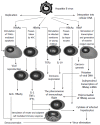Immunopathogenesis of chronic hepatitis B
- PMID: 25339804
- PMCID: PMC4202346
- DOI: 10.3748/wjg.v20.i39.14156
Immunopathogenesis of chronic hepatitis B
Abstract
Chronic hepatitis B (CHB) is a widespread infectious disease with unfavorable outcomes and life-threatening consequences for patients, in spite of modern vaccination and antiviral treatment modalities. Cutting-edge experimental approaches have demonstrated key pathways that involve cross-talk between viral particles and host immune cells. All events, including penetration of hepatitis B virus (HBV) particles into host cells, establishing persistence, and chronization of CHB infection, and possibility of complete elimination of HBV particles are controlled by the immune system. Researchers have paid special attention to the replication capacity of HBV in host cells, which is associated with cellular changes that reflect presentation of viral antigens and variability of HBV antigen features. In addition, specific HBV proteins have an immune-modulating ability to initiate molecular mechanisms that "avoid" control by the immune system. The relationship between immunological shifts and chronic infection stages has been intensively studied since it was recognized that the immune system is a direct participant in the recurrent (cyclic) nature of CHB. Understanding the wide diversity of molecular pathways and the crosstalk between innate and adaptive immune system components will provide fresh insight into CHB immune pathogenesis and the possibilities of developing new treatment strategies for this disease.
Keywords: Antiviral drugs; Chronic hepatitis B; Hepatocellular carcinoma; Immune response; Immunopathogenesis.
Figures



References
-
- Shi Z, Yang Y, Ma L, Li X, Schreiber A. Lamivudine in late pregnancy to interrupt in utero transmission of hepatitis B virus: a systematic review and meta-analysis. Obstet Gynecol. 2010;116:147–159. - PubMed
-
- Shi Z, Li X, Ma L, Yang Y. Hepatitis B immunoglobulin injection in pregnancy to interrupt hepatitis B virus mother-to-child transmission-a meta-analysis. Int J Infect Dis. 2010;14:e622–e634. - PubMed
-
- Janssen HL, van Zonneveld M, Schalm SW. Hepatitis B. N Engl J Med. 2004;350:2719–2720. - PubMed
-
- Shi Z, Li X, Yang Y, Ma L, Schreiber A. Obstetrical management of fulminant viral hepatitis in late pregnancy. Reproductive Sys Sexual Disord. 2012;1:102.
Publication types
MeSH terms
Substances
LinkOut - more resources
Full Text Sources
Other Literature Sources

